合成生物学 ›› 2023, Vol. 4 ›› Issue (3): 444-463.DOI: 10.12211/2096-8280.2023-003
功能拓扑的理性设计及其在合成生物学中的应用
孙智1, 杨宁1, 娄春波2, 汤超1, 杨晓静1
- 1.北京大学定量生物学中心,北京大学-清华大学生命科学联合中心,北京大学前沿学科交叉研究院,北京大学,北京 100871
2.中国科学院深圳先进技术研究院,细胞与基因线路设计中心,广东 深圳 518000
-
收稿日期:2023-01-02修回日期:2023-02-09出版日期:2023-06-30发布日期:2023-07-05 -
通讯作者:汤超,杨晓静 -
作者简介:孙智 (1994—),男,博士后。研究方向为定量合成生物学,人工生命系统的理性设计。 E-mail:sunz@pku.edu.cn杨宁 (1995—),男,博士研究生。研究方向为复杂系统、定量生物学。 E-mail:yn_biophy@pku.edu.cn汤超 (1958—),男,中国科学院院士,讲席教授,博士生导师。研究方向为物理生物学,系统生物学,统计物理和复杂系统。 E-mail:tangc@pku.edu.cn杨晓静 (1978—),女,副研究员。研究方向为系统生物学,定量生物学,合成生物学。 E-mail:xiaojing_yang@pku.edu.cn -
基金资助:国家重点研发计划(2018YFA0900700);北京大学-清华大学生命科学联合中心博士后基金
Rational design for functional topology and its applications in synthetic biology
SUN Zhi1, YANG Ning1, LOU Chunbo2, TANG Chao1, YANG Xiaojing1
- 1.Center for Quantitative Biology,Peking-Tsinghua Center for Life Sciences,Academy for Advanced Interdisciplinary Studies,Peking University,Beijing 100871,China
2.Cell and Gene Circuit Design Center,Shenzhen Institute of Advanced Technology,Chinese Academy of Sciences,Shenzhen 518000,Guangdong,China
-
Received:2023-01-02Revised:2023-02-09Online:2023-06-30Published:2023-07-05 -
Contact:TANG Chao, YANG Xiaojing
摘要:
生物网络以超乎寻常的精度、可靠性和鲁棒性执行着各种各样复杂的功能。网络的拓扑结构、动力学性质与功能之间密切相关。如何定量刻画这种关系,找到复杂多样的生物网络的底层设计规律是系统生物学和合成生物学的巨大挑战。本文对功能拓扑的理性设计及其在合成生物学中的应用进行了综述。生物网络在统计性质上不同于随机网络,其结构呈现出模块化的趋势,本文首先总结了自然生物系统中出现的高频模块及其功能,回顾了最近系统生物学对于功能拓扑设计原理的探索,包括目前搜索功能拓扑的两种常用计算方法,同时对理论获得的典型功能拓扑进行了总结。继而总结了近年来实际合成生物学系统中功能拓扑的设计和构建,以基于转录调控的基因回路为主,按照其内部调控节点的数目,系统地介绍了不同拓扑结构被用来实现的具体功能及其典型实例。最后,介绍了近期自动化设计集成基因线路的发展、非转录多层次调控机制以及网络鲁棒性的设计原理,并简单探讨了对于复杂功能拓扑设计的机遇和挑战。
中图分类号:
引用本文
孙智, 杨宁, 娄春波, 汤超, 杨晓静. 功能拓扑的理性设计及其在合成生物学中的应用[J]. 合成生物学, 2023, 4(3): 444-463.
SUN Zhi, YANG Ning, LOU Chunbo, TANG Chao, YANG Xiaojing. Rational design for functional topology and its applications in synthetic biology[J]. Synthetic Biology Journal, 2023, 4(3): 444-463.
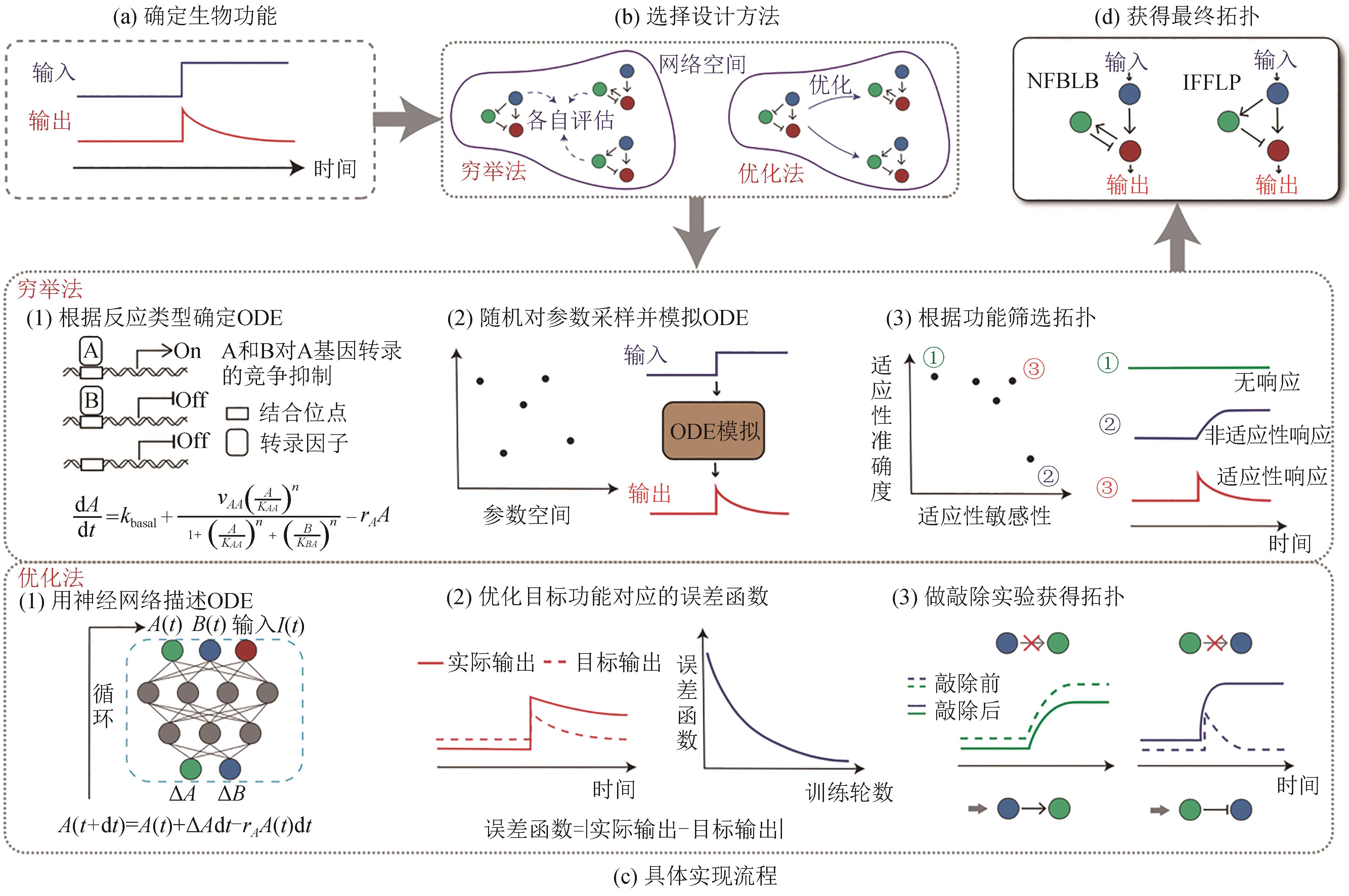
图1 生物功能网络的理性设计流程(a)确定需要研究的生物功能。(b)选择设计方法:穷举法或优化法。(c)两种方法的具体实现流程。穷举法:根据反应类型确定常微分方程(ODE),并随机对参数采样并模拟ODE,最后根据功能筛选拓扑。优化法:用神经网络描述ODE,并优化目标功能对应的误差函数,最后通过敲除实验获得拓扑。(d)获得最终的拓扑结构
Fig. 1 Rational design for biological networks(a) Identification of biological functions. (b) Two typical design methods: enumeration and optimization. (c) Workflow for these methods. Enumeration method: determining ODE (ordinary differential equation) according to reaction types, randomly sampling parameters to simulate ODE, and finally filtering topological networks with their functions as criteria. Optimization method: describing ODE by neural network to optimize the error function, and finally obtaining the topological networks by knockout experiments. (d) Determination of the final topological networks
| 功能 | 表型 | 拓扑 | 备注 |
|---|---|---|---|
| 适应性 | 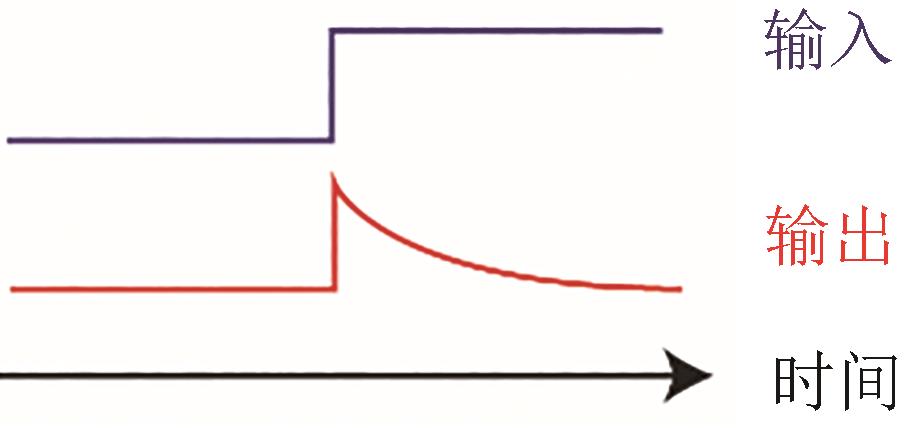 | 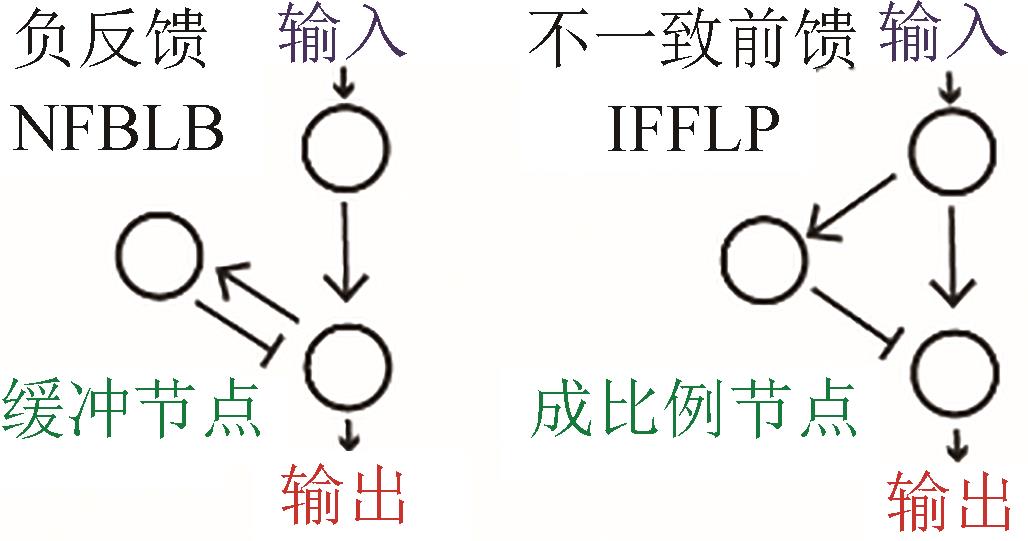 | 酶促反应网络 Me, et al., 2009[ |
| 振荡 | 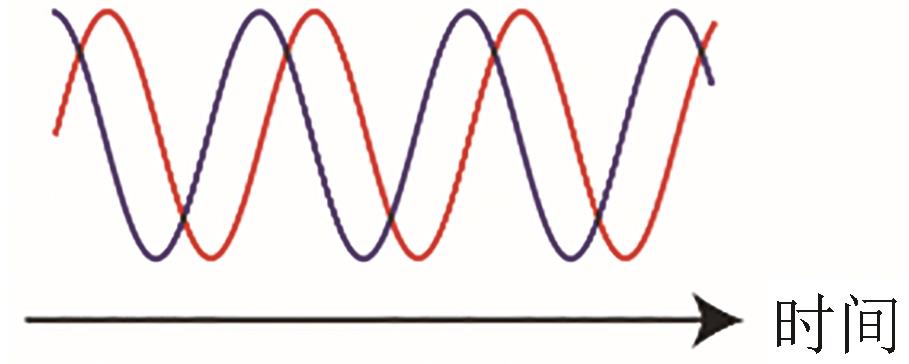 | 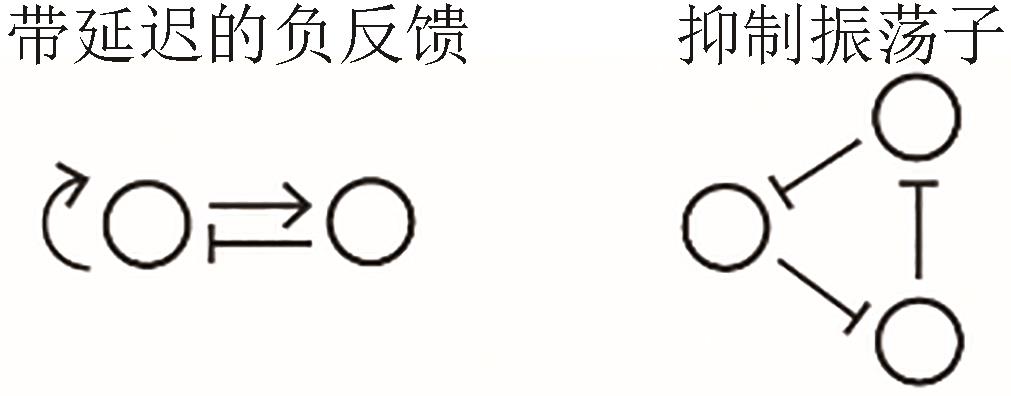 | Wagner, 2005[ Elowitz and Leibler, 2000[ |
| 双稳态 | 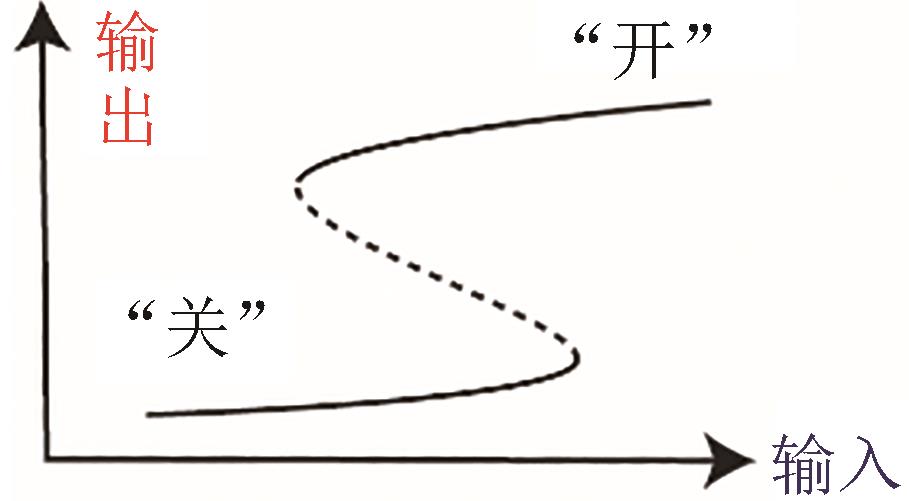 | 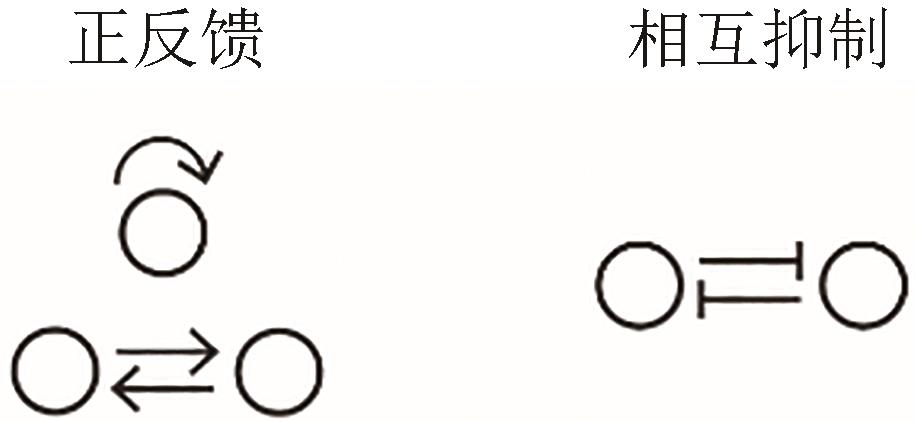 | Shah and Sarkar, 2011[ |
| 持续性检测 | 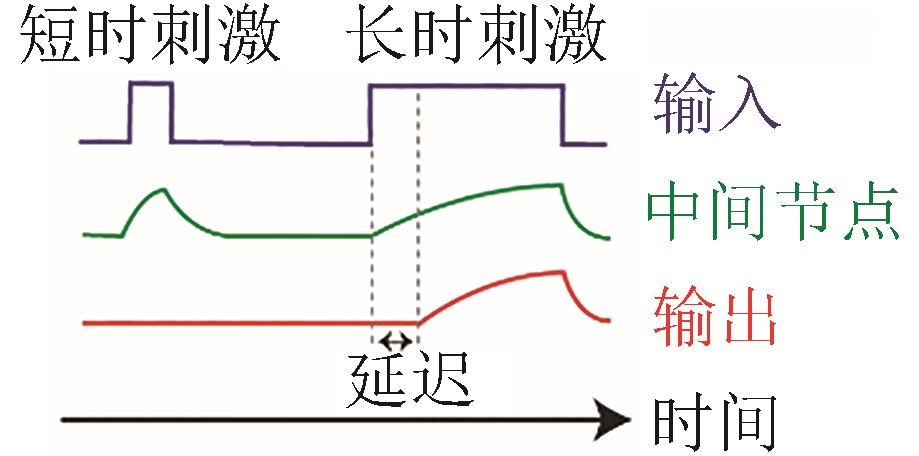 | 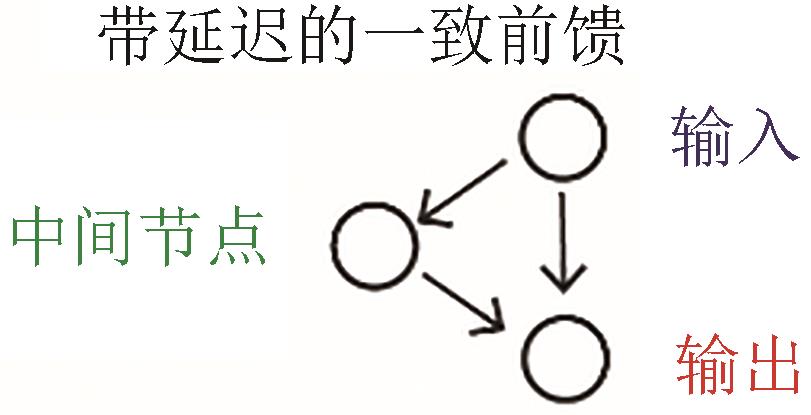 | Alon, 2007[ |
| 抗噪 | 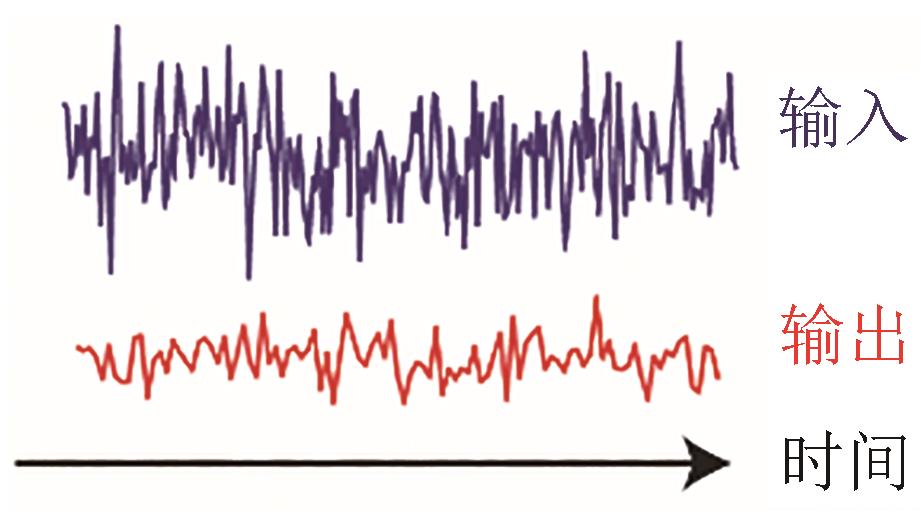 | 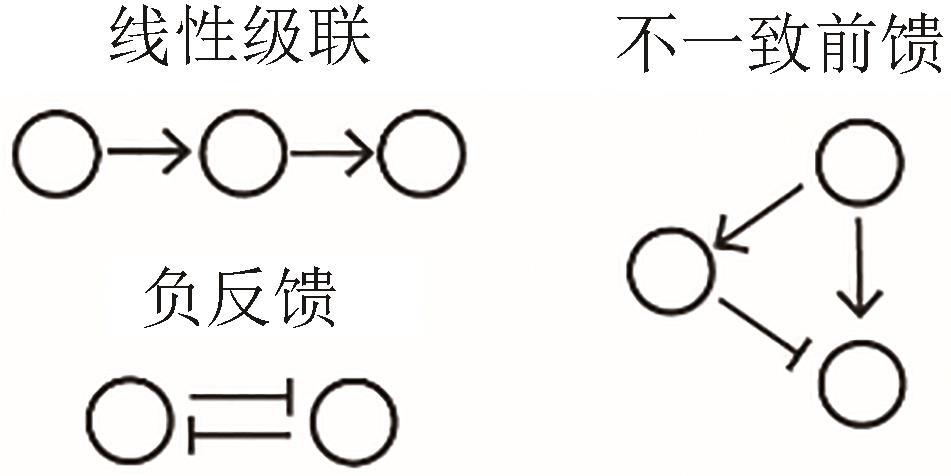 | Nie, et al., 2020[ |
| 体节发育 | 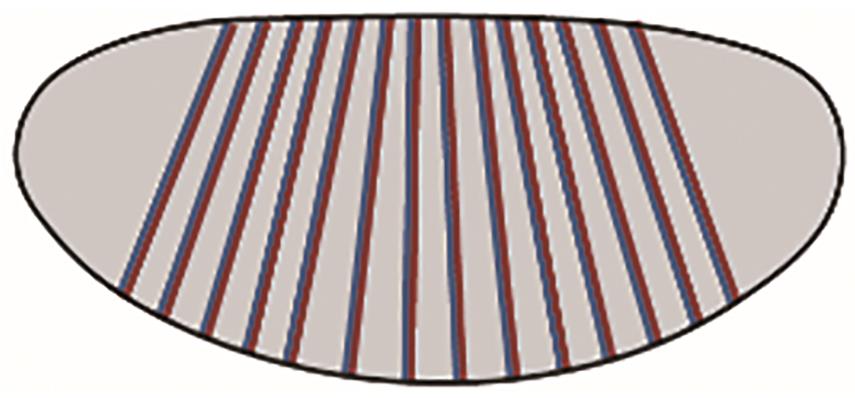 | 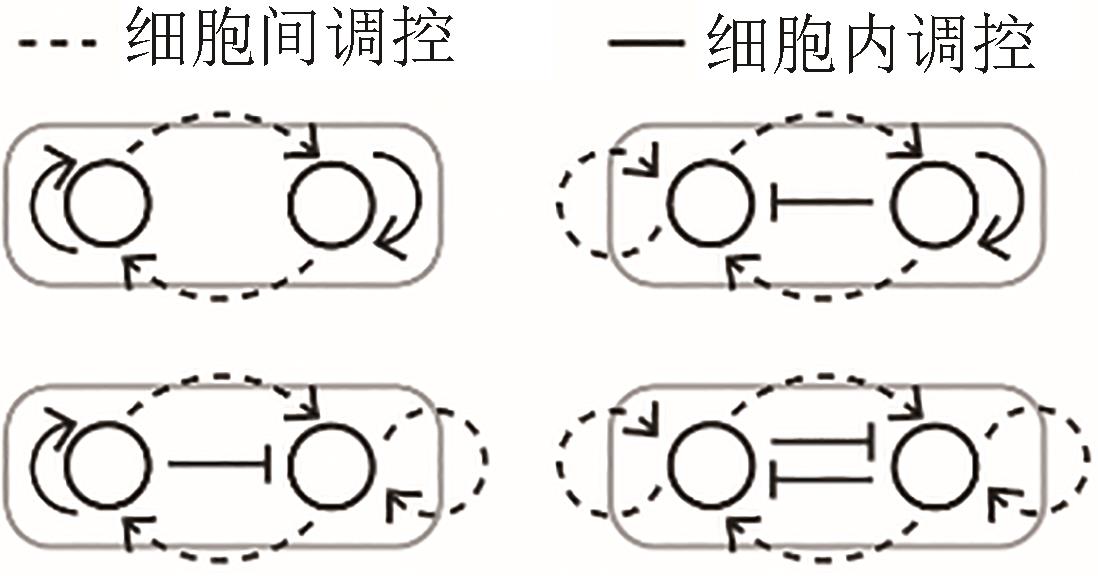 | Ma, et al., 2006[ |
| 细胞极化 | 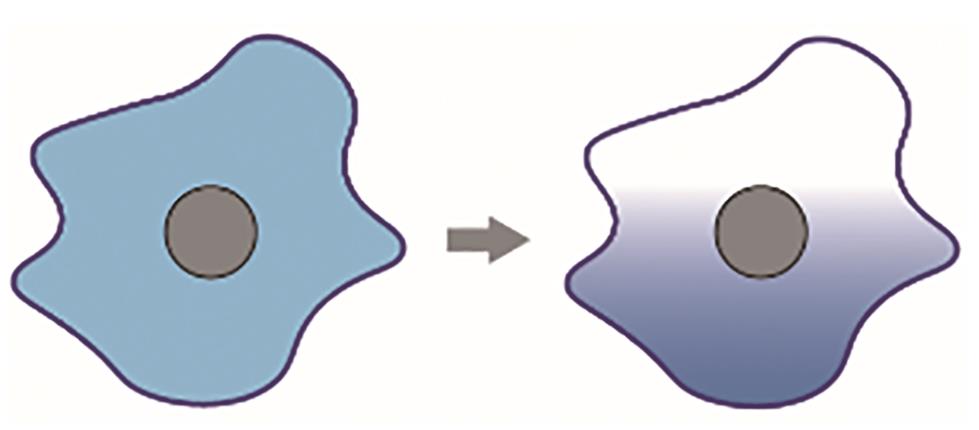 | 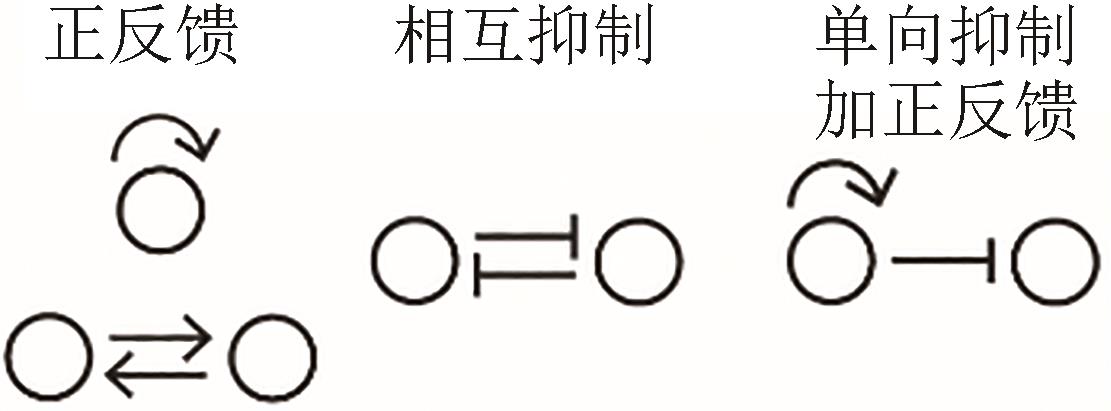 | Chau,et al., 2012[ |
| 适应性/振荡双功能 | 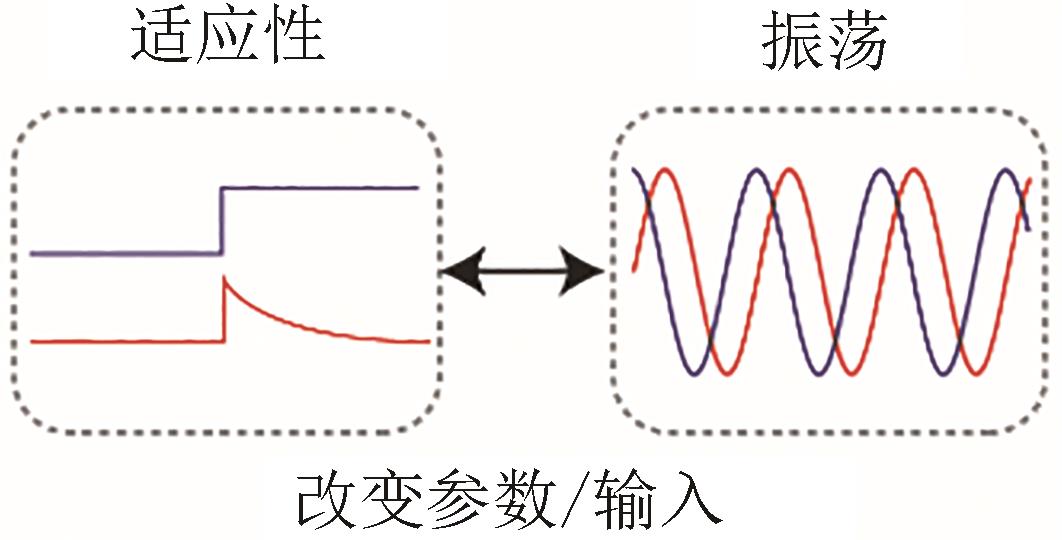 | 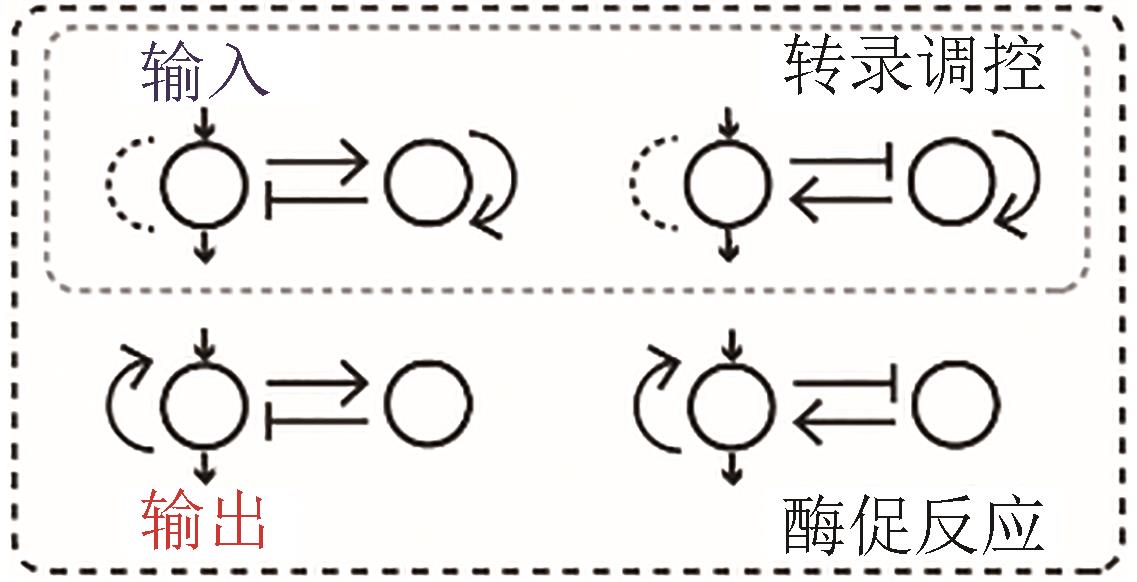 | Zhang, et al., 2019[ |
| 调频/调幅响应 | 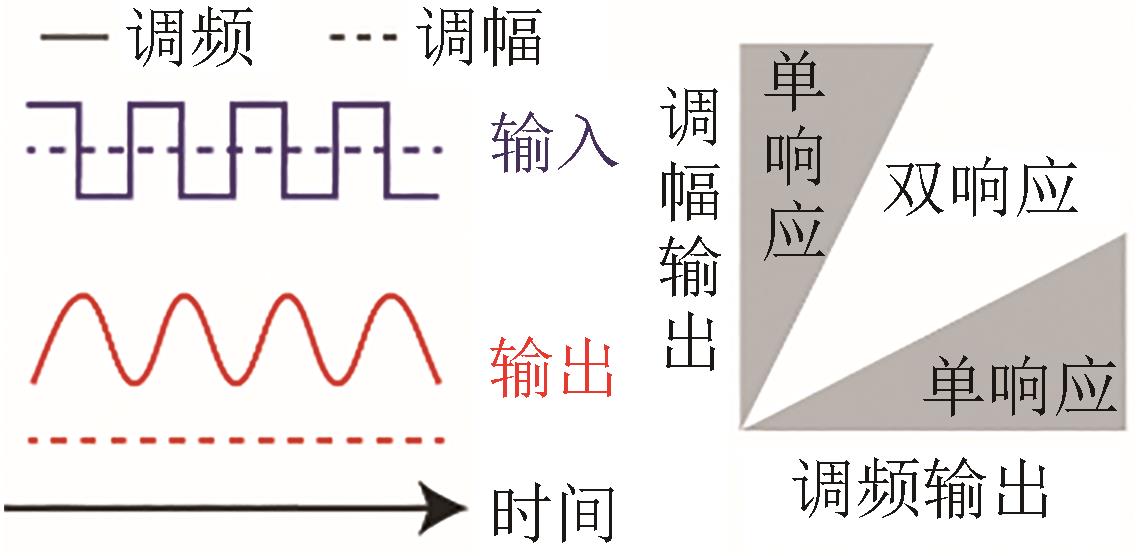 | 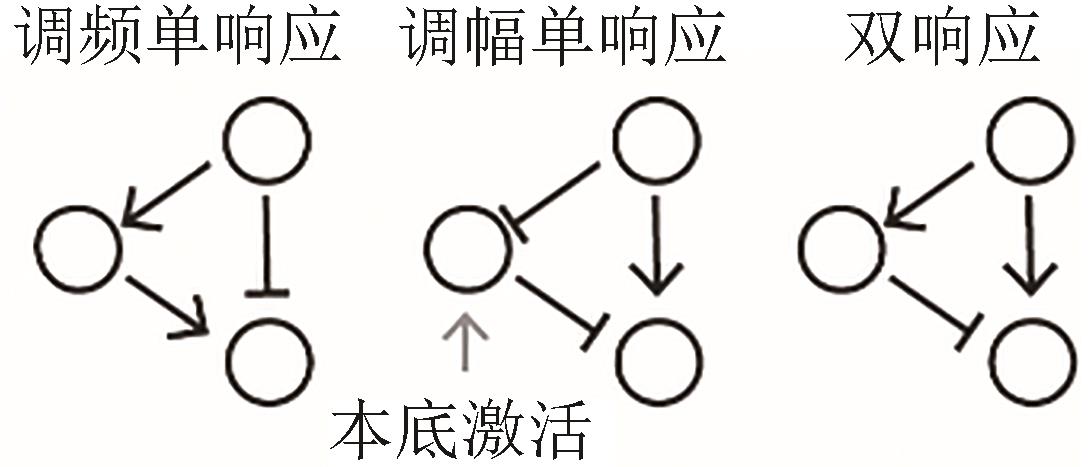 | 转录调控网络 Gao, et al., 2018[ |
表1 理论上获得的典型功能拓扑
Table 1 Typical functional topology developed theoretically
| 功能 | 表型 | 拓扑 | 备注 |
|---|---|---|---|
| 适应性 |  |  | 酶促反应网络 Me, et al., 2009[ |
| 振荡 |  |  | Wagner, 2005[ Elowitz and Leibler, 2000[ |
| 双稳态 |  |  | Shah and Sarkar, 2011[ |
| 持续性检测 |  |  | Alon, 2007[ |
| 抗噪 |  |  | Nie, et al., 2020[ |
| 体节发育 |  |  | Ma, et al., 2006[ |
| 细胞极化 |  |  | Chau,et al., 2012[ |
| 适应性/振荡双功能 |  |  | Zhang, et al., 2019[ |
| 调频/调幅响应 |  |  | 转录调控网络 Gao, et al., 2018[ |
| 线路类型 | 节点数/设计层次 | 拓扑结构/线路特点 | 可执行功能 | 主要基因元件或模块 |
|---|---|---|---|---|
| 基本转录调控线路 | 单节点 | 自抑制 | 降低表达噪声; 加速响应完成时间; 剂量响应线性化 | TetR自抑制;aTc剂量效应[ TetR自抑制结合光感元件LOV2响应光强度剂量[ |
| 自激活 | 双稳态自维持; “双模态”切换动力学; 参数分岔的“磁滞现象” | DBD-VP64自激活,pGal-DBD-VP64记忆瞬时乳糖浓度[ ZF-VP64自激活,响应多种瞬时刺激[ rtTA自激活线路,测试切换动力学[ tTA-VP16自激活,红霉素响应元件E-KRAB调控[ σ因子SigW自激活,利用RsiW调谐“磁滞区间”[ | ||
| 双节点 | “互抑制”型正反馈 | 双稳态自维持; “双模态”切换动力学; 参数分岔的“磁滞现象” | LacⅠ与CI构建toggle switch拨动开关[ RecA裂解CI控制双稳态切换,控制TraA表达诱发生物膜[ 利用mfLon蛋白酶控制拨动开关[ 利用UAS与pGal设计主开关,控制toggle switch开启[ PIP/E-KRAB构建toggle switch[ TALE元件设计toggle switch,耦联TALE自激活线路[ 正交TALE元件库,shRNA控制拨动开关,细胞分类器[ 定量RBS折叠自由能可预测设计toggle switch二态比例[ | |
| “激活-抑制”型负反馈 | 内源性自主振荡; 受迫振荡; “锁相”行为; 适应性响应 | LacⅠ-AraC,节点间负反馈结合自调控,设计自主振荡[ 温敏LacⅠ,补偿LacⅠ-AraC振荡线路的温度变化影响[ LacⅠ-AraC,周期性外源Arabinose驱动下的“锁相”振荡[ sense/anti-sense mRNA或siRNA设计负反馈振荡[ T7 RNAP与CRISPRi/dCpf1设计正负反馈耦合,实现RPA[ | ||
| 多节点 | 负反馈环路 | 三节点互抑制振荡 | TetR-LacⅠ-λCI的三节点互抑制负反馈环[ TetR-LacⅠ-λCI的三节点负反馈环简化,实现超稳定振荡[ 微流与光阱捕获技术,线路建库,筛选稳定振荡菌株[ | |
| 前馈线路 | 脉冲发生器(iFFL); 带通滤波器(iFFL); 信号加速器(cFFL) | 天然系统中的前馈实现信号加速与延迟的理论分析[ AHL扩散,LuxR-CI-GFP构建iFFL实现pulse generator[ LuxR-CI-GFP iFFL的空间动力学行为[ 光感pompC-LuxI-CI控制下游pLux-λ构建iFFL,边界探测[ tTA-Pip-E-KRAB构建iFFL,响应aTc剂量的band-pass filter[ 转录元件精确定量表征,构建iFFL的定量可预测设计[ | ||
| 组合逻辑线路 | 各类逻辑门线路 | 利用TetR-LacⅠ-λCI元件设计一系列逻辑门线路[ 双启动子控制阻遏蛋白的NOR Gate基本框架[ TetR family的正交NOT Gate阻遏蛋白挖掘[ | ||
| 时序逻辑线路 | 触点开关; 条件记忆学习线路; 锁存器线路 | LexA-LacⅠ NOR Gate,CI-CI434双稳态,组合构建触点开关[ tag-supD AND Gate、CI-CI434双稳态,巴甫洛夫样学习线路[ 双稳态与NOR Gate组合锁存结构,时序切换控制[ | ||
| 集成基因线路 | 多节点 | 组合前馈逻辑线路 | 逻辑门线路自动化设计; 逻辑切换动力学预测; 个性化线路设计 | Cello实现基因线路三输入逻辑真值表自动化CAD设计[ 四输入自动化设计,动力学过程表征与预测[ 基因组上Landing Pad超稳定低负载基因线路CAD设计[ 非模式菌的基础元件表征与线路CAD设计[ S. cerevisiae的基础元件设计表征与线路CAD设计[ |
| 多层次调控线路 | DNA层次 | 重组酶线路 | 带通滤波器; 表达顺序控制线路 | Bxb1、φC31、TP901重组酶受H2O2浓度调控,构建iFFL[ Cre、Flp、φC31受GIB、ABA诱导二聚化的自移除设计[ |
| RNA层次 | RNA元件 | RNA结合蛋白; RNA Replicon系统 | L7Ae、MS2结合蛋白的互抑制设计,RNA Replicon双稳态[ 使用TMP-DHFR可诱导降解标签调控L7Ae结合蛋白浓度[ | |
| CRISPR Circuit | CRISPR/Cas元件设计; Cas主蛋白中枢型线路 | TetR-CI-CRISPR/dCas9构建repressilator[ CRISPR/dCas9的转录抑制调控元件设计与表征[ dCas9*-PhlF融合构建减毒CRISPR调控系统[ 以dCas9、dCas12a为中枢蛋白设计的sgRNA调控线路等[ | ||
| 蛋白质层次 | 蛋白酶线路 | 降解肽切割调控; 分裂蛋白多聚化调控 | TEV/TVMV/SuMMV Protease移除/暴露降解肽标签调控设计[ Split TEV/TVMV/HCV Protease调控结合leucine zipper二聚化调控,设计logic gate、iFFL、protease toggle等功能[ | |
| 转录因子互作 | 多稳态基因调控线路 | GCN4、FKBP等结构域调控ZF结合蛋白二聚化多稳态线路[ | ||
| 翻译后修饰 | 超快速响应切换线路 | CRE1/STAT5设计磷酸化OR Gate,PTP-pHOG1对HOT1-pJH1去磷酸化NOT Gate,组合设计信号转导toggle switch[ | ||
| 鲁棒性控制线路 | 模块间“追溯活性” | 线路问题检查 | 负载表达动力学干扰; 元件模块化组装干扰 | pLac与lacO负载位点对LacⅠ的竞争,干扰表达动力学[ LuxR-NahR-GFP顺序组装后系统行为偏离预期[ |
| 功能修复线路 | 转录因子磷酸化线路; 激酶/磷酸酶元件开发; 减弱资源竞争模块设计; 公共资源自调节线路 | NRII(L16R)-NRII(H139N),STAT5-HKRR/ EnvZ激酶/磷酸酶活性改造,对OmpR-VP64调控活性控制,磷酸化水平负反馈线路控制表达[ ECF32 σ因子表达sRNA-mRNA负反馈;CasE切割mRNA 5′-UTR、miR-FF4设计iFFL线路等,减弱资源竞争效应[ 设计sgRNA靶向dCas9的自负反馈,公共中枢蛋白资源表达自调节,减弱下游模块间竞争[ | ||
| “线路-底盘”互作 | 线路问题检查 | 拓扑对生长的敏感性; 资源占用导致生长停滞 | AraC自激活与TetR-LacI互抑制对生长速率的不同敏感性[ pT7-T7 RNAP的自激活线路产生显著的表达量-生长异质性[ | |
| 功能修复线路 | 低拷贝基因线路设计; 表达负担负反馈线路; 毒性转录因子自负反馈; 生长速率补偿调控 | 基因组单拷贝整合的TetR-LacⅠ toggle switch[ 负担敏感phtpG1控制CRISPR/dCas9抑制的负反馈控制[ 转录因子CymR的自抑制诱导系统设计,减弱生长抑制毒性[ SpoTH元件降低ppGpp含量,维持生长速率恒定[ | ||
| 扰动噪声屏蔽 | 目的基因表达控制 | 稳定基因拷贝数变异; 组合iFFL/负反馈线路 | TALE设计线性抑制功能,稳定启动子表达受拷贝数影响[ rtTA-LacI/miR-FF3设计iFFL,排除转染量影响[ tTA-miR-FF4的iFFL与负反馈,组合控制[ | |
| 积分反馈控制线路 | σ/anti-σ; sense/anti-sense mRNA | SigW-RsiW的σ/anti-σ互作设计积分反馈控制[ tTA sense/anti-sense mRNA互作设计反馈控制[ | ||
| 鲁棒性功能拓扑发掘 | 基于拓扑约束的线路构建与扰动测试 | 基于拓扑穷举理论计算结果,T7 RNAP与CRISPR/dCpf1设计负反馈耦合线性弱自激活的基因线路,在输入信号改变、拓扑参数变异及底盘生理条件等进行系统扰动下均可实现RPA功能[ |
表2 已构建实现的基因线路及功能统计
Table 2 Functional topology that has been constructed and used in synthetic biology
| 线路类型 | 节点数/设计层次 | 拓扑结构/线路特点 | 可执行功能 | 主要基因元件或模块 |
|---|---|---|---|---|
| 基本转录调控线路 | 单节点 | 自抑制 | 降低表达噪声; 加速响应完成时间; 剂量响应线性化 | TetR自抑制;aTc剂量效应[ TetR自抑制结合光感元件LOV2响应光强度剂量[ |
| 自激活 | 双稳态自维持; “双模态”切换动力学; 参数分岔的“磁滞现象” | DBD-VP64自激活,pGal-DBD-VP64记忆瞬时乳糖浓度[ ZF-VP64自激活,响应多种瞬时刺激[ rtTA自激活线路,测试切换动力学[ tTA-VP16自激活,红霉素响应元件E-KRAB调控[ σ因子SigW自激活,利用RsiW调谐“磁滞区间”[ | ||
| 双节点 | “互抑制”型正反馈 | 双稳态自维持; “双模态”切换动力学; 参数分岔的“磁滞现象” | LacⅠ与CI构建toggle switch拨动开关[ RecA裂解CI控制双稳态切换,控制TraA表达诱发生物膜[ 利用mfLon蛋白酶控制拨动开关[ 利用UAS与pGal设计主开关,控制toggle switch开启[ PIP/E-KRAB构建toggle switch[ TALE元件设计toggle switch,耦联TALE自激活线路[ 正交TALE元件库,shRNA控制拨动开关,细胞分类器[ 定量RBS折叠自由能可预测设计toggle switch二态比例[ | |
| “激活-抑制”型负反馈 | 内源性自主振荡; 受迫振荡; “锁相”行为; 适应性响应 | LacⅠ-AraC,节点间负反馈结合自调控,设计自主振荡[ 温敏LacⅠ,补偿LacⅠ-AraC振荡线路的温度变化影响[ LacⅠ-AraC,周期性外源Arabinose驱动下的“锁相”振荡[ sense/anti-sense mRNA或siRNA设计负反馈振荡[ T7 RNAP与CRISPRi/dCpf1设计正负反馈耦合,实现RPA[ | ||
| 多节点 | 负反馈环路 | 三节点互抑制振荡 | TetR-LacⅠ-λCI的三节点互抑制负反馈环[ TetR-LacⅠ-λCI的三节点负反馈环简化,实现超稳定振荡[ 微流与光阱捕获技术,线路建库,筛选稳定振荡菌株[ | |
| 前馈线路 | 脉冲发生器(iFFL); 带通滤波器(iFFL); 信号加速器(cFFL) | 天然系统中的前馈实现信号加速与延迟的理论分析[ AHL扩散,LuxR-CI-GFP构建iFFL实现pulse generator[ LuxR-CI-GFP iFFL的空间动力学行为[ 光感pompC-LuxI-CI控制下游pLux-λ构建iFFL,边界探测[ tTA-Pip-E-KRAB构建iFFL,响应aTc剂量的band-pass filter[ 转录元件精确定量表征,构建iFFL的定量可预测设计[ | ||
| 组合逻辑线路 | 各类逻辑门线路 | 利用TetR-LacⅠ-λCI元件设计一系列逻辑门线路[ 双启动子控制阻遏蛋白的NOR Gate基本框架[ TetR family的正交NOT Gate阻遏蛋白挖掘[ | ||
| 时序逻辑线路 | 触点开关; 条件记忆学习线路; 锁存器线路 | LexA-LacⅠ NOR Gate,CI-CI434双稳态,组合构建触点开关[ tag-supD AND Gate、CI-CI434双稳态,巴甫洛夫样学习线路[ 双稳态与NOR Gate组合锁存结构,时序切换控制[ | ||
| 集成基因线路 | 多节点 | 组合前馈逻辑线路 | 逻辑门线路自动化设计; 逻辑切换动力学预测; 个性化线路设计 | Cello实现基因线路三输入逻辑真值表自动化CAD设计[ 四输入自动化设计,动力学过程表征与预测[ 基因组上Landing Pad超稳定低负载基因线路CAD设计[ 非模式菌的基础元件表征与线路CAD设计[ S. cerevisiae的基础元件设计表征与线路CAD设计[ |
| 多层次调控线路 | DNA层次 | 重组酶线路 | 带通滤波器; 表达顺序控制线路 | Bxb1、φC31、TP901重组酶受H2O2浓度调控,构建iFFL[ Cre、Flp、φC31受GIB、ABA诱导二聚化的自移除设计[ |
| RNA层次 | RNA元件 | RNA结合蛋白; RNA Replicon系统 | L7Ae、MS2结合蛋白的互抑制设计,RNA Replicon双稳态[ 使用TMP-DHFR可诱导降解标签调控L7Ae结合蛋白浓度[ | |
| CRISPR Circuit | CRISPR/Cas元件设计; Cas主蛋白中枢型线路 | TetR-CI-CRISPR/dCas9构建repressilator[ CRISPR/dCas9的转录抑制调控元件设计与表征[ dCas9*-PhlF融合构建减毒CRISPR调控系统[ 以dCas9、dCas12a为中枢蛋白设计的sgRNA调控线路等[ | ||
| 蛋白质层次 | 蛋白酶线路 | 降解肽切割调控; 分裂蛋白多聚化调控 | TEV/TVMV/SuMMV Protease移除/暴露降解肽标签调控设计[ Split TEV/TVMV/HCV Protease调控结合leucine zipper二聚化调控,设计logic gate、iFFL、protease toggle等功能[ | |
| 转录因子互作 | 多稳态基因调控线路 | GCN4、FKBP等结构域调控ZF结合蛋白二聚化多稳态线路[ | ||
| 翻译后修饰 | 超快速响应切换线路 | CRE1/STAT5设计磷酸化OR Gate,PTP-pHOG1对HOT1-pJH1去磷酸化NOT Gate,组合设计信号转导toggle switch[ | ||
| 鲁棒性控制线路 | 模块间“追溯活性” | 线路问题检查 | 负载表达动力学干扰; 元件模块化组装干扰 | pLac与lacO负载位点对LacⅠ的竞争,干扰表达动力学[ LuxR-NahR-GFP顺序组装后系统行为偏离预期[ |
| 功能修复线路 | 转录因子磷酸化线路; 激酶/磷酸酶元件开发; 减弱资源竞争模块设计; 公共资源自调节线路 | NRII(L16R)-NRII(H139N),STAT5-HKRR/ EnvZ激酶/磷酸酶活性改造,对OmpR-VP64调控活性控制,磷酸化水平负反馈线路控制表达[ ECF32 σ因子表达sRNA-mRNA负反馈;CasE切割mRNA 5′-UTR、miR-FF4设计iFFL线路等,减弱资源竞争效应[ 设计sgRNA靶向dCas9的自负反馈,公共中枢蛋白资源表达自调节,减弱下游模块间竞争[ | ||
| “线路-底盘”互作 | 线路问题检查 | 拓扑对生长的敏感性; 资源占用导致生长停滞 | AraC自激活与TetR-LacI互抑制对生长速率的不同敏感性[ pT7-T7 RNAP的自激活线路产生显著的表达量-生长异质性[ | |
| 功能修复线路 | 低拷贝基因线路设计; 表达负担负反馈线路; 毒性转录因子自负反馈; 生长速率补偿调控 | 基因组单拷贝整合的TetR-LacⅠ toggle switch[ 负担敏感phtpG1控制CRISPR/dCas9抑制的负反馈控制[ 转录因子CymR的自抑制诱导系统设计,减弱生长抑制毒性[ SpoTH元件降低ppGpp含量,维持生长速率恒定[ | ||
| 扰动噪声屏蔽 | 目的基因表达控制 | 稳定基因拷贝数变异; 组合iFFL/负反馈线路 | TALE设计线性抑制功能,稳定启动子表达受拷贝数影响[ rtTA-LacI/miR-FF3设计iFFL,排除转染量影响[ tTA-miR-FF4的iFFL与负反馈,组合控制[ | |
| 积分反馈控制线路 | σ/anti-σ; sense/anti-sense mRNA | SigW-RsiW的σ/anti-σ互作设计积分反馈控制[ tTA sense/anti-sense mRNA互作设计反馈控制[ | ||
| 鲁棒性功能拓扑发掘 | 基于拓扑约束的线路构建与扰动测试 | 基于拓扑穷举理论计算结果,T7 RNAP与CRISPR/dCpf1设计负反馈耦合线性弱自激活的基因线路,在输入信号改变、拓扑参数变异及底盘生理条件等进行系统扰动下均可实现RPA功能[ |
| 1 | MILO R, SHEN-ORR S, ITZKOVITZ S, et al. Network motifs: simple building blocks of complex networks[J]. Science, 2002, 298(5594): 824-827. |
| 2 | JEONG H, TOMBOR B, ALBERT R, et al. The large-scale organization of metabolic networks[J]. Nature, 2000, 407(6804): 651-654. |
| 3 | SHEN-ORR S S, MILO R, MANGAN S, et al. Network motifs in the transcriptional regulation network of Escherichia coli [J]. Nature Genetics, 2002, 31(1): 64-68. |
| 4 | LIM W A, LEE C M, TANG C. Design principles of regulatory networks: searching for the molecular algorithms of the cell[J]. Molecular Cell, 2013, 49(2): 202-212. |
| 5 | ROSENFELD N, ELOWITZ M B, ALON U. Negative autoregulation speeds the response times of transcription networks[J]. Journal of Molecular Biology, 2002, 323(5): 785-793. |
| 6 | ISAACS F J, HASTY J, CANTOR C R, et al. Prediction and measurement of an autoregulatory genetic module[J]. Proceedings of the National Academy of Sciences of the United States of America, 2003, 100(13): 7714-7719. |
| 7 | GUAN Y, CHEN X M, SHAO B, et al. Mitigating host burden of genetic circuits by engineering autonegatively regulated parts and improving functional prediction[J]. ACS Synthetic Biology, 2022, 11(7): 2361-2371. |
| 8 | ALON U. Network motifs: theory and experimental approaches[J]. Nature Reviews Genetics, 2007, 8(6): 450-461. |
| 9 | SNEPPEN K, KRISHNA S, SEMSEY S. Simplified models of biological networks[J]. Annual Review of Biophysics, 2010, 39: 43-59. |
| 10 | OPPENHEIM A B, KOBILER O, STAVANS J, et al. Switches in bacteriophage lambda development[J]. Annual Review of Genetics, 2005, 39: 409-429. |
| 11 | BECSKEI A, SERRANO L. Engineering stability in gene networks by autoregulation[J]. Nature, 2000, 405(6786): 590-593. |
| 12 | HSU C, SCHERRER S, BUETTI-DINH A, et al. Stochastic signalling rewires the interaction map of a multiple feedback network during yeast evolution[J]. Nature Communications, 2012, 3: 682. |
| 13 | NIE Q, QIAO L X, QIU Y C, et al. Noise control and utility: from regulatory network to spatial patterning[J]. Science China Mathematics, 2020, 63(3): 425-440. |
| 14 | BOURKE ARNVIG K, PEDERSEN S, SNEPPEN K. Thermodynamics of heat-shock response[J]. Physical Review Letters, 2000, 84(13): 3005-3008. |
| 15 | KRISHNA S, JENSEN M H, SNEPPEN K. Minimal model of spiky oscillations in NF-κB signaling[J]. Proceedings of the National Academy of Sciences of the United States of America, 2006, 103(29): 10840-10845. |
| 16 | HOELLER O, GONG D, WEINER O D. How to understand and outwit adaptation[J]. Developmental Cell, 2014, 28(6): 607-616. |
| 17 | MA W Z, LAI L H, OUYANG Q, et al. Robustness and modular design of the Drosophila segment polarity network[J]. Molecular Systems Biology, 2006, 2: 70. |
| 18 | MA W Z, TRUSINA A, EL-SAMAD H, et al. Defining network topologies that can achieve biochemical adaptation[J]. Cell, 2009, 138(4): 760-773. |
| 19 | BARKAI N, LEIBLER S. Robustness in simple biochemical networks[J]. Nature, 1997, 387(6636): 913-917. |
| 20 | STELLING J, GILLES E D, DOYLE F J. Robustness properties of circadian clock architectures[J]. Proceedings of the National Academy of Sciences of the United States of America, 2004, 101(36): 13210-13215. |
| 21 | SHAH N A, SARKAR C A. Robust network topologies for generating switch-like cellular responses[J]. PLoS Computational Biology, 2011, 7(6): e1002085. |
| 22 | WAGNER A. Circuit topology and the evolution of robustness in two-gene circadian oscillators[J]. Proceedings of the National Academy of Sciences of the United States of America, 2005, 102(33): 11775-11780. |
| 23 | CHAU A H, WALTER J M, GERARDIN J, et al. Designing synthetic regulatory networks capable of self-organizing cell polarization[J]. Cell, 2012, 151(2): 320-332. |
| 24 | ZHANG M Y, TANG C. Bi-functional biochemical networks[J]. Physical Biology, 2018, 16(1): 016001. |
| 25 | GAO Z M, CHEN S H, QIN S S, et al. Network motifs capable of decoding transcription factor dynamics[J]. Scientific Reports, 2018, 8: 3594. |
| 26 | QIAO L X, ZHAO W, TANG C, et al. Network topologies that can achieve dual function of adaptation and noise attenuation[J]. Cell Systems, 2019, 9(3): 271-285.e7. |
| 27 | QIAO L X, ZHANG Z B, ZHAO W, et al. Network design principle for robust oscillatory behaviors with respect to biological noise[J]. eLife, 2022, 11: e76188. |
| 28 | ELOWITZ M B, LEIBLER S. A synthetic oscillatory network of transcriptional regulators[J]. Nature, 2000, 403(6767): 335-338. |
| 29 | FRANÇOIS P, HAKIM V. Design of genetic networks with specified functions by evolution in silico [J]. Proceedings of the National Academy of Sciences of the United States of America, 2004, 101(2): 580-585. |
| 30 | FRANÇOIS P, SIGGIA E D. A case study of evolutionary computation of biochemical adaptation[J]. Physical Biology, 2008, 5(2): 026009. |
| 31 | FRANÇOIS P, SIGGIA E D. Predicting embryonic patterning using mutual entropy fitness and in silico evolution[J]. Development, 2010, 137(14): 2385-2395. |
| 32 | LECUN Y, BENGIO Y, HINTON G. Deep learning[J]. Nature, 2015, 521(7553): 436-444. |
| 33 | SHEN J X, LIU F, TU Y H, et al. Finding gene network topologies for given biological function with recurrent neural network[J]. Nature Communications, 2021, 12: 3125. |
| 34 | CHEN F, LI C H. Inferring structural and dynamical properties of gene networks from data with deep learning[J]. NAR Genomics and Bioinformatics, 2022, 4(3): lqac068. |
| 35 | NEVOZHAY D, ADAMS R M, MURPHY K F, et al. Negative autoregulation linearizes the dose-response and suppresses the heterogeneity of gene expression[J]. Proceedings of the National Academy of Sciences of the United States of America, 2009, 106(13): 5123-5128. |
| 36 | NEVOZHAY D, ZAL T, BALÁZSI G. Transferring a synthetic gene circuit from yeast to mammalian cells[J]. Nature Communications, 2013, 4: 1451. |
| 37 | GUINN M T, BALÁZSI G. Noise-reducing optogenetic negative-feedback gene circuits in human cells[J]. Nucleic Acids Research, 2019, 47(14): 7703-7714. |
| 38 | AJO-FRANKLIN C M, DRUBIN D A, ESKIN J A, et al. Rational design of memory in eukaryotic cells[J]. Genes & Development, 2007, 21(18): 2271-2276. |
| 39 | BURRILL D R, INNISS M C, BOYLE P M, et al. Synthetic memory circuits for tracking human cell fate[J]. Genes & Development, 2012, 26(13): 1486-1497. |
| 40 | LONGO D M, HOFFMANN A, TSIMRING L S, et al. Coherent activation of a synthetic mammalian gene network[J]. Systems and Synthetic Biology, 2010, 4(1): 15-23. |
| 41 | KRAMER B P, FUSSENEGGER M. Hysteresis in a synthetic mammalian gene network[J]. Proceedings of the National Academy of Sciences of the United States of America, 2005, 102(27): 9517-9522. |
| 42 | CHEN D, ARKIN A P. Sequestration-based bistability enables tuning of the switching boundaries and design of a latch[J]. Molecular Systems Biology, 2012, 8(1): 620. |
| 43 | GARDNER T S, CANTOR C R, COLLINS J J. Construction of a genetic toggle switch in Escherichia coli [J]. Nature, 2000, 403(6767): 339-342. |
| 44 | KOBAYASHI H, KAERN M, ARAKI M, et al. Programmable cells: interfacing natural and engineered gene networks[J]. Proceedings of the National Academy of Sciences of the United States of America, 2004, 101(22): 8414-8419. |
| 45 | CAMERON D E, COLLINS J J. Tunable protein degradation in bacteria[J]. Nature Biotechnology, 2014, 32(12): 1276-1281. |
| 46 | WU M, SU R Q, LI X H, et al. Engineering of regulated stochastic cell fate determination[J]. Proceedings of the National Academy of Sciences of the United States of America, 2013, 110(26): 10610-10615. |
| 47 | KRAMER B P, VIRETTA A U, DAOUD-EL BABA M, et al. An engineered epigenetic transgene switch in mammalian cells[J]. Nature Biotechnology, 2004, 22(7): 867-870. |
| 48 | LEBAR T, BEZELJAK U, GOLOB A, et al. A bistable genetic switch based on designable DNA-binding domains[J]. Nature Communications, 2014, 5: 5007. |
| 49 | LI Y Q, JIANG Y, CHEN H, et al. Modular construction of mammalian gene circuits using TALE transcriptional repressors[J]. Nature Chemical Biology, 2015, 11(3): 207-213. |
| 50 | CHEN S B, ZHANG H Q, SHI H D, et al. Automated design of genetic toggle switches with predetermined bistability[J]. ACS Synthetic Biology, 2012, 1(7): 284-290. |
| 51 | STRICKER J, COOKSON S, BENNETT M R, et al. A fast, robust and tunable synthetic gene oscillator[J]. Nature, 2008, 456(7221): 516-519. |
| 52 | HUSSAIN F, GUPTA C, HIRNING A J, et al. Engineered temperature compensation in a synthetic genetic clock[J]. Proceedings of the National Academy of Sciences of the United States of America, 2014, 111(3): 972-977. |
| 53 | MONDRAGÓN-PALOMINO O, DANINO T, SELIMKHANOV J, et al. Entrainment of a population of synthetic genetic oscillators[J]. Science, 2011, 333(6047): 1315-1319. |
| 54 | TIGGES M, MARQUEZ-LAGO T T, STELLING J, et al. A tunable synthetic mammalian oscillator[J]. Nature, 2009, 457(7227): 309-312. |
| 55 | TIGGES M, DÉNERVAUD N, GREBER D, et al. A synthetic low-frequency mammalian oscillator[J]. Nucleic Acids Research, 2010, 38(8): 2702-2711. |
| 56 | SUN Z, WEI W J, ZHANG M Y, et al. Synthetic robust perfect adaptation achieved by negative feedback coupling with linear weak positive feedback[J]. Nucleic Acids Research, 2022, 50(4): 2377-2386. |
| 57 | POTVIN-TROTTIER L, LORD N D, VINNICOMBE G, et al. Synchronous long-term oscillations in a synthetic gene circuit[J]. Nature, 2016, 538(7626): 514-517. |
| 58 | LURO S, POTVIN-TROTTIER L, OKUMUS B, et al. Isolating live cells after high-throughput, long-term, time-lapse microscopy[J]. Nature Methods, 2020, 17(1): 93-100. |
| 59 | MANGAN S, ALON U. Structure and function of the feed-forward loop network motif[J]. Proceedings of the National Academy of Sciences of the United States of America, 2003, 100(21): 11980-11985. |
| 60 | MANGAN S, ZASLAVER A, ALON U. The coherent feedforward loop serves as a sign-sensitive delay element in transcription networks[J]. Journal of Molecular Biology, 2003, 334(2): 197-204. |
| 61 | KALIR S, MANGAN S, ALON U. A coherent feed-forward loop with a SUM input function prolongs flagella expression in Escherichia coli [J]. Molecular Systems Biology, 2005, 1: 2005.0006. |
| 62 | MANGAN S, ITZKOVITZ S, ZASLAVER A, et al. The incoherent feed-forward loop accelerates the response-time of the gal system of Escherichia coli [J]. Journal of Molecular Biology, 2006, 356(5): 1073-1081. |
| 63 | KAPLAN S, BREN A, DEKEL E, et al. The incoherent feed-forward loop can generate non-monotonic input functions for genes[J]. Molecular Systems Biology, 2008, 4: 203. |
| 64 | GOENTORO L, SHOVAL O, KIRSCHNER M W, et al. The incoherent feedforward loop can provide fold-change detection in gene regulation[J]. Molecular Cell, 2009, 36(5): 894-899. |
| 65 | BASU S, MEHREJA R, THIBERGE S, et al. Spatiotemporal control of gene expression with pulse-generating networks[J]. Proceedings of the National Academy of Sciences of the United States of America, 2004, 101(17): 6355-6360. |
| 66 | BASU S, GERCHMAN Y, COLLINS C H, et al. A synthetic multicellular system for programmed pattern formation[J]. Nature, 2005, 434(7037): 1130-1134. |
| 67 | TABOR J J, SALIS H M, SIMPSON Z B, et al. A synthetic genetic edge detection program[J]. Cell, 2009, 137(7): 1272-1281. |
| 68 | GREBER D, FUSSENEGGER M. An engineered mammalian band-pass network[J]. Nucleic Acids Research, 2010, 38(18): e174. |
| 69 | ZONG Y Q, ZHANG H M, LYU C, et al. Insulated transcriptional elements enable precise design of genetic circuits[J]. Nature Communications, 2017, 8: 52. |
| 70 | GUET C C, ELOWITZ M B, HSING W, et al. Combinatorial synthesis of genetic networks[J]. Science, 2002, 296(5572): 1466-1470. |
| 71 | TAMSIR A, TABOR J J, VOIGT C A. Robust multicellular computing using genetically encoded NOR gates and chemical 'wires'[J]. Nature, 2011, 469(7329): 212-215. |
| 72 | STANTON B C, NIELSEN A A K, TAMSIR A, et al. Genomic mining of prokaryotic repressors for orthogonal logic gates[J]. Nature Chemical Biology, 2014, 10(2): 99-105. |
| 73 | LOU C B, LIU X L, NI M, et al. Synthesizing a novel genetic sequential logic circuit: a push-on push-off switch[J]. Molecular Systems Biology, 2010, 6: 350. |
| 74 | ZHANG H Q, LIN M, SHI H D, et al. Programming a Pavlovian-like conditioning circuit in Escherichia coli [J]. Nature Communications, 2014, 5: 3102. |
| 75 | ANDREWS L B, NIELSEN A A K, VOIGT C A. Cellular checkpoint control using programmable sequential logic[J]. Science, 2018, 361(6408): eaap8987. |
| 76 | NIELSEN A A K, DER B S, SHIN J, et al. Genetic circuit design automation[J]. Science, 2016, 352(6281): aac7341. |
| 77 | SHIN J, ZHANG S Y, DER B S, et al. Programming Escherichia coli to function as a digital display[J]. Molecular Systems Biology, 2020, 16(3): e9401. |
| 78 | PARK Y, ESPAH BORUJENI A, GOROCHOWSKI T E, et al. Precision design of stable genetic circuits carried in highly-insulated E. coli genomic landing pads[J]. Molecular Systems Biology, 2020, 16(8): e9584. |
| 79 | TAKETANI M, ZHANG J B, ZHANG S Y, et al. Genetic circuit design automation for the gut resident species Bacteroides thetaiotaomicron[J]. Nature Biotechnology, 2020, 38(8): 962-969. |
| 80 | CHEN Y, ZHANG S Y, YOUNG E M, et al. Genetic circuit design automation for yeast[J]. Nature Microbiology, 2020, 5(11): 1349-1360. |
| 81 | RUBENS J R, SELVAGGIO G, LU T K. Synthetic mixed-signal computation in living cells[J]. Nature Communications, 2016, 7: 11658. |
| 82 | KIM T, WEINBERG B, WONG W, et al. Scalable recombinase-based gene expression cascades[J]. Nature Communications, 2021, 12(1): 2711. |
| 83 | WROBLEWSKA L, KITADA T, ENDO K, et al. Mammalian synthetic circuits with RNA binding proteins for RNA-only delivery[J]. Nature Biotechnology, 2015, 33(8): 839-841. |
| 84 | WAGNER T E, BECRAFT J R, BODNER K, et al. Small-molecule-based regulation of RNA-delivered circuits in mammalian cells[J]. Nature Chemical Biology, 2018, 14(11): 1043-1050. |
| 85 | HENNINGSEN J, SCHWARZ-SCHILLING M, LEIBL A, et al. Single cell characterization of a synthetic bacterial clock with a hybrid feedback loop containing dCas9-sgRNA[J]. ACS Synthetic Biology, 2020, 9(12): 3377-3387. |
| 86 | NIELSEN A A K, VOIGT C A. Multi-input CRISPR/Cas genetic circuits that interface host regulatory networks[J]. Molecular Systems Biology, 2014, 10(11): 763. |
| 87 | ANDERSON D A, VOIGT C A. Competitive dCas9 binding as a mechanism for transcriptional control[J]. Molecular Systems Biology, 2021, 17(11): e10512. |
| 88 | ZHANG S Y, VOIGT C A. Engineered dCas9 with reduced toxicity in bacteria: implications for genetic circuit design[J]. Nucleic Acids Research, 2018, 46(20): 11115-11125. |
| 89 | KUO J, YUAN R S, SÁNCHEZ C, et al. Toward a translationally independent RNA-based synthetic oscillator using deactivated CRISPR-Cas[J]. Nucleic Acids Research, 2020, 48(14): 8165-8177. |
| 90 | SANTOS-MORENO J, TASIUDI E, STELLING J, et al. Multistable and dynamic CRISPRi-based synthetic circuits[J]. Nature Communications, 2020, 11: 2746. |
| 91 | FERNANDEZ-RODRIGUEZ J, VOIGT C A. Post-translational control of genetic circuits using Potyvirus proteases[J]. Nucleic Acids Research, 2016, 44(13): 6493-6502. |
| 92 | GAO X J, CHONG L S, KIM M S, et al. Programmable protein circuits in living cells[J]. Science, 2018, 361(6408): 1252-1258. |
| 93 | CHEN Z B, LINTON J M, ZHU R H, et al. A synthetic protein-level neural network in mammalian cells[EB/OL]. bioRxiv, 2022[2022-12-31]. . |
| 94 | ZHU R H, DEL RIO-SALGADO J M, GARCIA-OJALVO J, et al. Synthetic multistability in mammalian cells[J]. Science, 2022, 375(6578): eabg9765. |
| 95 | MISHRA D, BEPLER T, TEAGUE B, et al. An engineered protein-phosphorylation toggle network with implications for endogenous network discovery[J]. Science, 2021, 373(6550): eaav0780. |
| 96 | JAYANTHI S, NILGIRIWALA K S, DEL VECCHIO D. Retroactivity controls the temporal dynamics of gene transcription[J]. ACS Synthetic Biology, 2013, 2(8): 431-441. |
| 97 | QIAN Y L, HUANG H H, JIMÉNEZ J I, et al. Resource competition shapes the response of genetic circuits[J]. ACS Synthetic Biology, 2017, 6(7): 1263-1272. |
| 98 | NILGIRIWALA K S, JIMÉNEZ J, RIVERA P M, et al. Synthetic tunable amplifying buffer circuit in E. coli [J]. ACS Synthetic Biology, 2015, 4(5): 577-584. |
| 99 | MISHRA D, RIVERA P M, LIN A, et al. A load driver device for engineering modularity in biological networks[J]. Nature Biotechnology, 2014, 32(12): 1268-1275. |
| 100 | JONES R D, QIAN Y L, ILIA K, et al. Robust and tunable signal processing in mammalian cells via engineered covalent modification cycles[J]. Nature Communications, 2022, 13: 1720. |
| 101 | HUANG H H, QIAN Y L, DEL VECCHIO D. A quasi-integral controller for adaptation of genetic modules to variable ribosome demand[J]. Nature Communications, 2018, 9: 5415. |
| 102 | JONES R D, QIAN Y L, SICILIANO V, et al. An endoribonuclease-based feedforward controller for decoupling resource-limited genetic modules in mammalian cells[J]. Nature Communications, 2020, 11(1): 5690. |
| 103 | FREI T, CELLA F, TEDESCHI F, et al. Characterization and mitigation of gene expression burden in mammalian cells[J]. Nature Communications, 2020, 11: 4641. |
| 104 | HUANG H H, BELLATO M, QIAN Y L, et al. dCas9 regulator to neutralize competition in CRISPRi circuits[J]. Nature Communications, 2021, 12: 1692. |
| 105 | ZHANG R, LI J, MELENDEZ-ALVAREZ J, et al. Topology-dependent interference of synthetic gene circuit function by growth feedback[J]. Nature Chemical Biology, 2020, 16(6): 695-701. |
| 106 | TAN C, MARGUET P, YOU L C. Emergent bistability by a growth-modulating positive feedback circuit[J]. Nature Chemical Biology, 2009, 5(11): 842-848. |
| 107 | LEE J W, GYORGY A, CAMERON D E, et al. Creating single-copy genetic circuits[J]. Molecular Cell, 2016, 63(2): 329-336. |
| 108 | CERONI F, BOO A, FURINI S, et al. Burden-driven feedback control of gene expression[J]. Nature Methods, 2018, 15(5): 387-393. |
| 109 | BARAJAS C, HUANG H H, GIBSON J, et al. Feedforward growth rate control mitigates gene activation burden[J]. Nature Communications, 2022, 13: 7054. |
| 110 | SEGALL-SHAPIRO T H, SONTAG E D, VOIGT C A. Engineered promoters enable constant gene expression at any copy number in bacteria[J]. Nature Biotechnology, 2018, 36(4): 352-358. |
| 111 | BLERIS L, XIE Z, GLASS D, et al. Synthetic incoherent feedforward circuits show adaptation to the amount of their genetic template[J]. Molecular Systems Biology, 2011, 7: 519. |
| 112 | LILLACCI G, BENENSON Y, KHAMMASH M. Synthetic control systems for high performance gene expression in mammalian cells[J]. Nucleic Acids Research, 2018, 46(18): 9855-9863. |
| 113 | AOKI S K, LILLACCI G, GUPTA A, et al. A universal biomolecular integral feedback controller for robust perfect adaptation[J]. Nature, 2019, 570(7762): 533-537. |
| 114 | FREI T, CHANG C H, FILO M, et al. A genetic mammalian proportional-integral feedback control circuit for robust and precise gene regulation[J]. Proceedings of the National Academy of Sciences of the United States of America, 2022, 119(24): e2122132119. |
| 115 | ROSENFELD N, YOUNG J W, ALON U, et al. Accurate prediction of gene feedback circuit behavior from component properties[J]. Molecular Systems Biology, 2007, 3: 143. |
| 116 | ROSENFELD N, YOUNG J W, ALON U, et al. Gene regulation at the single-cell level[J]. Science, 2005, 307(5717): 1962-1965. |
| 117 | SHOPERA T, HENSON W R, NG A, et al. Robust, tunable genetic memory from protein sequestration combined with positive feedback[J]. Nucleic Acids Research, 2015, 43(18): 9086-9094. |
| 118 | WU F Q, SU R Q, LAI Y C, et al. Engineering of a synthetic quadrastable gene network to approach Waddington landscape and cell fate determination[J]. eLife, 2017, 6: e23702. |
| 119 | SALIS H M, MIRSKY E A, VOIGT C A. Automated design of synthetic ribosome binding sites to control protein expression[J]. Nature Biotechnology, 2009, 27(10): 946-950. |
| 120 | SHI W J, MA W Z, XIONG L Y, et al. Adaptation with transcriptional regulation[J]. Scientific Reports, 2017, 7: 42648. |
| 121 | ALON U. An introduction to systems biology: design principles of biological circuits[M]. Boca Raton, FL: Chapman & Hall/CRC, 2007. |
| 122 | ZHANG H M, CHEN S B, SHI H D, et al. Measurements of gene expression at steady state improve the predictability of part assembly[J]. ACS Synthetic Biology, 2016, 5(3): 269-273. |
| 123 | GREEN A A, KIM J, MA D, et al. Complex cellular logic computation using ribocomputing devices[J]. Nature, 2017, 548(7665): 117-121. |
| 124 | KIM J, ZHOU Y, CARLSON P D, et al. De novo-designed translation-repressing riboregulators for multi-input cellular logic[J]. Nature Chemical Biology, 2019, 15(12): 1173-1182. |
| 125 | CHEN Y J, LIU P, NIELSEN A A K, et al. Characterization of 582 natural and synthetic terminators and quantification of their design constraints[J]. Nature Methods, 2013, 10(7): 659-664. |
| 126 | MEYER A J, SEGALL-SHAPIRO T H, GLASSEY E, et al. Escherichia coli "Marionette" strains with 12 highly optimized small-molecule sensors[J]. Nature Chemical Biology, 2019, 15(2): 196-204. |
| 127 | HOSSAIN A, LOPEZ E, HALPER S M, et al. Automated design of thousands of nonrepetitive parts for engineering stable genetic systems[J]. Nature Biotechnology, 2020, 38(12): 1466-1475. |
| 128 | LOU C B, STANTON B, CHEN Y J, et al. Ribozyme-based insulator parts buffer synthetic circuits from genetic context[J]. Nature Biotechnology, 2012, 30(11): 1137-1142. |
| 129 | GOROCHOWSKI T E, ESPAH BORUJENI A, PARK Y, et al. Genetic circuit characterization and debugging using RNA-seq[J]. Molecular Systems Biology, 2017, 13(11): 952. |
| 130 | ESPAH BORUJENI A, ZHANG J, DOOSTHOSSEINI H, et al. Genetic circuit characterization by inferring RNA polymerase movement and ribosome usage[J]. Nature Communications, 2020, 11: 5001. |
| 131 | FONTANARROSA P, DOOSTHOSSEINI H, BORUJENI A E, et al. Genetic circuit dynamics: hazard and glitch analysis[J]. ACS Synthetic Biology, 2020, 9(9): 2324-2338. |
| 132 | JONES T S, OLIVEIRA S M D, MYERS C J, et al. Genetic circuit design automation with Cello 2.0[J]. Nature Protocols, 2022, 17(4): 1097-1113. |
| 133 | DEL VECCHIO D, NINFA A J, SONTAG E D. Modular cell biology: retroactivity and insulation[J]. Molecular Systems Biology, 2008, 4: 161. |
| [1] | 高歌, 边旗, 王宝俊. 合成基因线路的工程化设计研究进展与展望[J]. 合成生物学, 2025, 6(1): 45-64. |
| [2] | 李冀渊, 吴国盛. 合成生物学视域下有机体的两种隐喻[J]. 合成生物学, 2025, 6(1): 190-202. |
| [3] | 焦洪涛, 齐蒙, 邵滨, 蒋劲松. DNA数据存储技术的法律治理议题[J]. 合成生物学, 2025, 6(1): 177-189. |
| [4] | 唐兴华, 陆钱能, 胡翌霖. 人类世中对合成生物学的哲学反思[J]. 合成生物学, 2025, 6(1): 203-212. |
| [5] | 徐怀胜, 石晓龙, 刘晓光, 徐苗苗. DNA存储的关键技术:编码、纠错、随机访问与安全性[J]. 合成生物学, 2025, 6(1): 157-176. |
| [6] | 石婷, 宋展, 宋世怡, 张以恒. 体外生物转化(ivBT):生物制造的新前沿[J]. 合成生物学, 2024, 5(6): 1437-1460. |
| [7] | 柴猛, 王风清, 魏东芝. 综合利用木质纤维素生物转化合成有机酸[J]. 合成生物学, 2024, 5(6): 1242-1263. |
| [8] | 邵明威, 孙思勉, 杨时茂, 陈国强. 基于极端微生物的生物制造[J]. 合成生物学, 2024, 5(6): 1419-1436. |
| [9] | 陈雨, 张康, 邱以婧, 程彩云, 殷晶晶, 宋天顺, 谢婧婧. 微生物电合成技术转化二氧化碳研究进展[J]. 合成生物学, 2024, 5(5): 1142-1168. |
| [10] | 郑皓天, 李朝风, 刘良叙, 王嘉伟, 李恒润, 倪俊. 负碳人工光合群落的设计、优化与应用[J]. 合成生物学, 2024, 5(5): 1189-1210. |
| [11] | 夏孔晨, 徐维华, 吴起. 光酶催化混乱性反应的研究进展[J]. 合成生物学, 2024, 5(5): 997-1020. |
| [12] | 陈子苓, 向阳飞. 类器官技术与合成生物学协同研究进展[J]. 合成生物学, 2024, 5(4): 795-812. |
| [13] | 蔡冰玉, 谭象天, 李伟. 合成生物学在干细胞工程化改造中的研究进展[J]. 合成生物学, 2024, 5(4): 782-794. |
| [14] | 谢皇, 郑义蕾, 苏依婷, 阮静怡, 李永泉. 放线菌聚酮类化合物生物合成体系重构研究进展[J]. 合成生物学, 2024, 5(3): 612-630. |
| [15] | 查文龙, 卜兰, 訾佳辰. 中药药效成分群的合成生物学研究进展[J]. 合成生物学, 2024, 5(3): 631-657. |
| 阅读次数 | ||||||
|
全文 |
|
|||||
|
摘要 |
|
|||||
